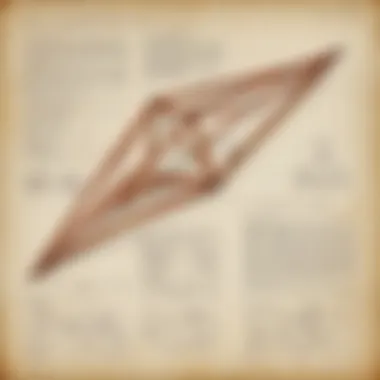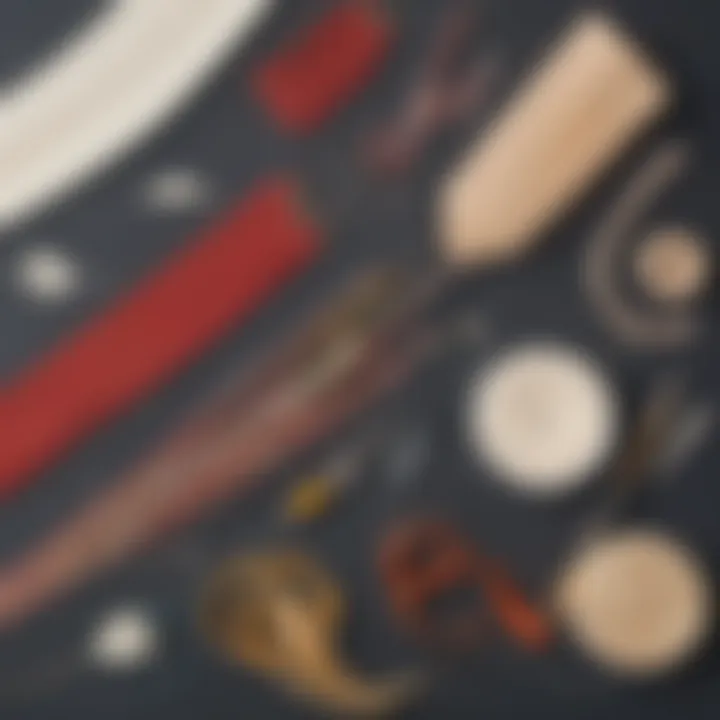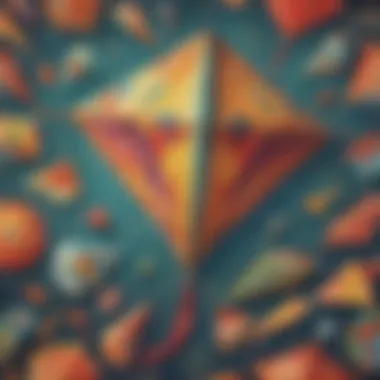Kite Making Materials: A Comprehensive Guide


Intro
Kites have fascinated humans for centuries. They teach us the basics of aerodynamics, physics, and engineering principles. Making a kite can be an exciting project for children and their caregivers. This activity not only sparks creativity but also raises questions about the materials we use and how they influence the kite's ability to fly. In this guide, we will explore the different materials necessary for creating a kite, touching on their unique properties and their significance in the craft.
Through this exploration, young learners and educators alike will discover how various kite-making materials work together, enhancing the understanding of fundamental scientific concepts while engaging in a fun, hands-on activity.
Science Fun Facts
Kites have a rich history, and there are several interesting facts about them. For instance, did you know that the earliest recorded kites date back to China in 500 BC? They were often made from materials such as silk and bamboo. This shows how materials affect not just the design but also the use of kites in different cultures.
Kites have been used for many purposes, including military reconnaissance and scientific experimentation.
Here are some quirky facts that make kites even more intriguing:
- The largest kite measured over 3,000 square feet.
- Some kites are designed to carry small objects, like cameras, for aerial photography.
- Kite flying festivals around the world attract thousands of participants each year.
Discover the Wonders of Science
Kite making allows children to engage with several scientific concepts in a fun way. Educators can explore the principles of lift, drag, and thrust while constructing kites.
Exploring Various Scientific Concepts
These concepts include:
- Aerodynamics: Understanding how air moves around the kite.
- Forces: Learning about lift and the weight of the kite material.
Educational Videos and Animations
Educators can find valuable videos on platforms like YouTube that illustrate how kites fly. These resources can enhance lessons on physics.
Interactive Learning Tools
Using online simulators, kids can experiment with different kite shapes and materials, discovering what makes a kite successful.
Real-Life Applications of Science
Kite flying isn't just fun. It's also used in meteorology and physics research. Observations from kites can help scientists collect data from hard-to-reach areas.
Science Quiz Time
Testing knowledge is always a great way to reinforce learning.
Interactive Quizzes
Kids can take part in quiz activities to gauge their understanding of the materials used in kite making.
Multiple Choice Questions
Here’s a simple question: What material helps a kite to be lightweight, yet strong?
a) Paper
b) Aluminum
c) Plastic
d) Cotton
Brain Teasers and Puzzles
Consider this: If you add a tail to your kite, how does that impact its stability in the air?
Learning Through Gamification
Using games where children can earn points for correct answers will increase their engagement and enjoyment.
Science Experiment Showcase
Kite making can also involve practical experiments.
Fun and Engaging Experiments
A common experiment is to test different materials to see how they perform in the wind.
Step-by-Step Instructions
- Gather your materials: lightweight paper, wooden sticks, tape, and string.
- Create your kite shape and frame.
- Attach the materials securely, ensuring a sturdy structure.
- Test your kite in an open area and observe how it flies.
Materials List
- Lightweight paper
- Bamboo skewers or wooden dowels
- String
- Tape
- Scissors
Safety Tips and Precautions
Always ensure children are supervised during activities, especially when using scissors and other sharp tools.
This guide has introduced you to key kite making materials and provided insight into their properties. The journey of making kites combines creativity with scientific learning, making it an enriching experience for young enthusiasts and their educators.


Prologue to Kite Making
Kite making is not just a fun activity; it is a blend of art, science, and engineering. Understanding the materials involved plays a crucial role in creating efficient and awe-inspiring designs. This section explores the significance of kite making, emphasizing the benefits of both creativity and hands-on learning. By engaging in this process, young creators, along with their caregivers, can enrich their comprehension of physics while simultaneously honing their design skills.
The History of Kites
Kites have a rich history that dates back thousands of years. They are believed to have originated in China, with early records suggesting their use for military signaling and as tools for measuring distances. Eventually, the art of kite flying spread to other parts of Asia and the world, adapting to local cultures and technologies.
In the 18th century, Benjamin Franklin famously flew a kite in a thunderstorm, which led to important discoveries about electricity. Kites have since evolved from simple, traditional designs to complex structures utilized in both recreational and scientific applications. Understanding this history enriches the kite making experience, connecting the past with the present.
Kites in Modern Education
In schools, kite making serves a dual purpose. It is an engaging method to teach fundamental science concepts, such as aerodynamics, material properties, and environmental factors. When students construct kites, they learn about balance, weight distribution, and how different materials affect flight.
Another advantage of kite making is the development of teamwork and social skills. Group projects encourage collaboration among students, as they share ideas and solve problems together. Furthermore, kite flying itself is a great outdoor activity that fosters physical exercise and connection with nature. This blend of education and recreation highlights the relevance of kite making in modern curriculums.
"Kite making can bridge the gap between theoretical concepts and practical understanding, making learning enjoyable and memorable."
Essential Kite Frame Materials
Kite frame materials are critical for the structure of any kite. They provide the necessary support and shape, enabling the kite to stay airborne. The effectiveness of a kite heavily depends on how well these materials are chosen. The selection involves understanding their weight, flexibility, and strength. Choosing the right frame materials can enhance the stability and performance of the kite when it is in flight.
In this section, we will look into three primary materials used for kite frames: wooden dowels, fiberglass rods, and plastic straws. Each of these materials has unique characteristics that make them suitable for different types of kites. Knowing about these options allows builders to make informed choices that cater to the specific needs of their kite projects.
Wooden Dowels
Wooden dowels are a traditional choice for kite frames. Their natural strength and rigidity make them a reliable material for supporting the structure. They are widely available in various diameters, which allows for versatility in kite designs. A common advantage of wooden dowels is their ability to absorb minor impacts without breaking. This means that kites built with this material can withstand some rough handling.
However, there are considerations one must keep in mind. Wooden dowels can add significant weight to the kite. This extra weight can impact the kite’s ability to gain altitude during flight. Moreover, wooden dowels are vulnerable to moisture. If they get wet, they can warp or weaken, which can lead to structural failure during an exciting fly.
To sum up, wooden dowels are great for creating durable kite frames. They provide strong support, but proper care and consideration for weight management are vital for optimal performance.
Fiberglass Rods
Fiberglass rods offer a lightweight and flexible alternative to wooden dowels. They are often the preferred material among experienced kite makers. Their design helps them absorb wind energy, giving kites the necessary bend without breaking. This flexibility is essential in allowing the kite to adapt to changing wind conditions.
In terms of weight, fiberglass rods are significantly lighter than wood. This reduced weight enhances flight performance, allowing kites to reach higher altitudes. Fiberglass is also resistant to moisture, making it a more durable option in varying weather conditions. This quality ensures that your kite can fly even if there is a chance of rain.
Still, fiberglass rods come with some drawbacks. They tend to be more expensive compared to wooden dowels and require proper handling. Improper bending can lead to cracking, and they should be stored carefully to prevent damage.
Plastic Straws
Plastic straws are a surprisingly effective option for making kite frames, especially for novice builders. They are lightweight, inexpensive, and readily available. This makes them an attractive choice for school projects and group activities. Their light weight helps kites stay buoyant, thus achieving important lift.
While they are easy to work with, there are performance considerations. Plastic straws are not as strong as wood or fiberglass, especially when it comes to withstanding strong winds. They can easily bend or break under pressure. This is why they are often used in small or simple kite designs rather than larger and more complex types.
Additionally, combining plastic straws with other materials can enhance the overall strength of a kite. For example, some builders use plastic straws in conjunction with wooden dowels to create a balance between weight and support.
In short, plastic straws are a great choice for basic kite designs. They are ideal for beginners, but builders should be mindful of their limitations in terms of strength.
Choosing the Right Kite Fabric
Selecting the right fabric for kite making is a critical part of the overall process. The fabric directly influences the kite's performance in the air. Also, it affects how the kite interacts with wind and how durable it is against weather conditions. Understanding the options available ensures that builders, especially children guided by caregivers, can tailor their creations to specific purposes and environments. The ideal fabric balances weight, strength, and flexibility to ensure a successful flight experience.
Paper Options
Paper is often the first fabric choice for novice kite makers. It is widely available, lightweight, and easy to work with. Many children may have paper at home, making it accessible for craft projects. The colors and patterns of paper can also enhance the aesthetic appeal of the kite. However, paper has its limitations. It can tear easily in strong winds or if it gets wet. Therefore, it is best suited for gentle breezes and short flights. Caregivers should supervise the use of paper, especially in outdoor settings, to prevent damage.
- Types of Paper:
- Kraft paper offers a rustic look and decent durability.
- Tissue paper provides vibrant colors and a light structure.
- Cardstock adds strength but is heavier.
"When using paper, a strong frame is essential to support the weight without risking collapse during flight."
Ripstop Nylon
Ripstop nylon is a versatile option often favored by experienced kite builders. Its name comes from the way it is woven, using a technique that prevents small tears from becoming larger. This durability makes it suitable for varying weather conditions. Light and water-resistant, ripstop nylon can endure strong winds and light rain, extending the kite's lifespan significantly. The material comes in many colors, creating visually striking designs.
- Benefits of Ripstop Nylon:
- Lightweight yet strong.
- Easy to clean and maintain.
- Available in a variety of vibrant colors.
Lightweight Polyester
Lightweight polyester is another excellent choice for kite fabrics. Similar to ripstop nylon, it offers durability while remaining lightweight. Polyester is commonly used in outdoor products due to its resistance to fading and stretching. This fabric performs well in a range of wind conditions, making it suitable for both novice and intermediate kite builders. It can provide a balance between ease of handling and high performance.
- Advantages of Lightweight Polyester:
- Excellent water resistance.
- Maintains shape during flights.
- Fade-resistant colors for long-lasting designs.
Kite String and Line Materials


Choosing the correct string or line materials is crucial in kite making as they directly affect the performance of the kite. Kite string controls how the kite lifts and navigates through the air. It is the link between the flyer and the kite, providing stability and allowing the flyer to maneuver the kite effectively. Understanding various options for kite strings will help in picking the right one for your project.
Nylon String
Nylon string is a popular selection among kite makers because it is strong and lightweight. Its resistance to stretching means that it can withstand strong winds without losing its shape or control. Factors to consider include:
- Strength: Nylon string can handle heavy kites. It also maintains its integrity in high-wind conditions.
- Weather Resistance: This material does not break down easily when exposed to moisture, making it suitable for various weather conditions.
- Cost: It is usually affordable and accessible for most kite-making projects.
Additionally, nylon string comes in various thicknesses and colors, allowing for some customization to meet personal preferences. Its durability often makes it a favorite among beginners and experienced kite makers alike.
Cotton String
Cotton string offers a different set of properties that can be beneficial depending on the kite design and flying conditions. While it may not be as strong as nylon, its natural fiber provides a unique texture and feel. Here are some notable points:
- Eco-friendliness: Cotton strings are biodegradable, which can be a desirable factor for environmentally conscious kite makers.
- Grip: The fabric-like surface makes it easier to hold onto, which can enhance handling during kite flying.
- Limited Stretch: While it does stretch a bit when under tension, this can be beneficial for some kite types. However, it is essential to monitor its use to prevent snapping in strong winds.
Cotton string is also generally more affordable. This can make it a viable option for educational activities where cutting costs is necessary.
Braided Lines
Braided lines provide a strong, versatile option for kites and are especially useful for larger, heavier designs. They combine several thin threads into one, creating a line that offers fantastic strength without excessive weight. Key aspects to consider include:
- Strength-to-Weight Ratio: Braided lines often are lighter than solid strings, making them ideal for high-performance kites.
- Flexibility: These lines can be easier to handle, increasing user-friendliness during flight.
- Variety: Braided lines come in different materials, including nylon and polyester, allowing flexibility in choosing depending on project needs.
Additional Kite Building Components
In the process of kite making, several components play vital roles beyond just the frame and the fabric. These additional kite building components can significantly enhance the functionality and aesthetics of kites. Understanding their importance allows young makers to appreciate how each element contributes to the overall success of their kite flying experience.
Adhesives and Tapes
Adhesives and tapes are essential for assembling various parts of a kite. They provide the necessary bond that ensures the components stay intact during flights. There are several types of adhesives suitable for kite making, including glue sticks, craft glue, and double-sided tape.
When choosing adhesives, consider the following factors:
- Strength: The adhesive must be strong enough to withstand wind pressure.
- Drying Time: Fast-drying adhesives are ideal for quick assembly.
- Flexibility: A flexible bond helps absorb stress without breaking.
Using tape is often preferred for temporary arrangements or when working with younger children, as it is easier to manage and requires no drying time. Tapes come in various widths and strengths, making them versatile for different materials.
"Choosing the right adhesive is as crucial as selecting the right frame materials for your kite."
Decorative Materials
Kite decoration adds personality and flair. Decorative materials can range from colored markers to fabric paint and stickers. Engaging in decoration helps children express creativity while learning about design concepts.
Consider these decoration techniques:
- Painting: Using fabric paint directly on the kite fabric allows a personal touch.
- Stickers: Easy to apply, stickers can be placed on paper kites for added visuals.
- Markers: Permanent markers can create detailed designs.
When selecting decorative materials, think about:
- Weight: Avoid heavy materials to not disrupt balance.
- Weather Resistance: Make sure decorations can withstand outdoor elements, especially moisture.
Weight Balancing Materials
Proper weight distribution is crucial for stable flight. Lightweight materials help balance a kite correctly, which influences how well it catches the wind. Common materials include small stones, washers, or even sand.
Key points to consider with weight balancing include:
- Location: Weight should be strategically placed, often towards the tail or bottom, to maintain stability.
- Adjustability: Using temporary materials allows for adjustments during testing flights.
- Weight Amount: The right amount of weight avoids making the kite too heavy, which could inhibit flight.
By focusing on these additional components, young kite builders will gain a deeper understanding of the complexities involved in kite making. Integrating adhesives, decoration, and weight balancing can significantly enhance the overall building process.
The Science Behind Material Selection
Understanding the science behind material selection is crucial in the art of kite making. The right combination of materials affects not only the performance of the kite but also its longevity and usability. Choosing materials based on scientific principles can elevate the quality of the final product. Different properties such as weight, strength, and resistance to various environmental factors must be considered to achieve the desired flight performance.
One major aspect is the aerodynamics of the materials chosen. Kites need to be designed in a way that allows them to harness wind efficiently. If the materials are too heavy, the kite may struggle to gain altitude. Additionally, how the materials interact with airflows determines stability and maneuverability. Thus, comprehending these principles is essential not just for effective design but also for educational purposes. It allows young learners to explore concepts in physics actively and practically while enjoying the creative process of making kites.
Another significant consideration is the durability of materials. Kites often endure various weather conditions, including sun, wind, and rain. Therefore, selecting materials that can withstand such elements is key to ensuring that the kite lasts through multiple uses, thus supporting sustainable practices and avoiding waste.
Aerodynamics and Lightness
When creating a kite, its ability to soar gracefully in the air relies heavily on aerodynamics and the lightness of its components. Aerodynamics refers to how air interacts with the kite as it moves through it. A well-designed kite has a form that minimizes air resistance while maximizing lift. The weight of the materials plays a vital role; lighter materials can help in achieving this balance.
Some excellent choices for light frame materials include:
- Bamboo
- Carbon fiber
- Ultralight nylon
These materials provide a sturdy frame without adding excess weight.


Lightness, influenced by the choice of fabric and framework, enhances responsiveness and control, enabling the kite flyer to perform tricks or maintain stability during flight. An understanding of these dynamics encourages students to think critically about their choices and the implications of those decisions. Ownership over material selection encourages deeper learning and engagement.
Durability and Weather Resistance
While lightness is important, the durability of materials cannot be overlooked. A kite that cannot withstand gusts of wind or bouts of rain will quickly become a source of frustration rather than joy. Different materials offer varying levels of durability and weather resistance.
Some options for durable kite making include:
- Ripstop nylon: This material is known for its ability to resist tearing, making it ideal for strong winds.
- Fiberglass rods: They are lightweight yet robust, suitable for withstanding pressures during flight.
- Plastic coverings: These can provide a waterproof barrier, protecting the kite fabric from becoming damaged in the rain.
Additionally, careful consideration of adhesive and construction methods contributes significantly to the longevity of a kite. By reinforcing connections and strategically aligning materials, a well-built kite is likely to withstand various weather conditions.
Engaging with these principles allows young kite makers to appreciate the intricacies of design while fostering a respect for science. Recognizing the interplay between material selection and performance enriches the overall experience and cultivates a deeper interest in fields like physics and engineering.
Safety Considerations in Kite Making
Understanding safety in kite making ensures a positive experience. When working with materials, it is important to carefully choose those that are safe not only for the makers but also for the environment. This section will discuss how to prioritize safety in kite making and create an enjoyable crafting environment for everyone involved.
Choosing Non-toxic Materials
Selecting non-toxic materials is essential in kite making. Many traditional materials can include harmful substances such as lead-based paints or synthetic glues that may emit fumes. Using non-toxic alternatives helps ensure that children interact with safe items.
When choosing materials, consider these points:
- Kite Fabric: Opt for materials like ripstop nylon or lightweight polyester. These fabrics are generally durable and safe.
- Decoration Supplies: Use water-based markers and paint, which do not contain harmful chemicals.
- Adhesives: Look for child-safe glues or tapes, such as PVA glue, that do not have strong fumes.
By selecting non-toxic materials, you help create a safe environment for children to explore their creativity without health concerns.
Safe Construction Practices
Safety does not end with material selection. Following safe construction practices is equally important and can make a significant difference in the kite-making experience. Here are some crucial practices to consider:
- Supervised Workspaces: Ensure adult supervision when children are using tools or adhesives. This will help prevent accidents and enforce proper usage of materials.
- Proper Handling of Tools: Teach children how to handle scissors and other cutting tools carefully. Show them how to cut away from their bodies and keep fingers clear of cutting edges.
- Fixing Sharp Edges: If your kite frame has sharp edges, use sandpaper to smooth them. This reduces the risk of cuts and injuries during construction.
- Cleaning Up: After kiting activities, encourage cleaning up areas immediately. This teaches responsibility and helps prevent trips or falls.
"Safety is not just a priority; it is a necessary component of any creative process."
By integrating these safe construction practices into the kite-making process, children can enjoy not only the joy of creating but also the assurance of a safe and friendly environment.
Engaging Activities with Kite Making
Engaging activities centered around kite making offer more than just an opportunity for creativity; they serve as a bridge connecting practical hands-on experiences with theoretical concepts in science. For children aged 6-12, these activities foster collaboration and ignite curiosity. By diving into the world of kites, young minds can explore the relationship between materials, design, and the principles of flight. These engagements are essential as they promote not only individual skill development but also teamwork and problem-solving.
Interactive Materials Exploration
Interactive materials exploration is a core component of kite making activities. This process involves introducing various materials available for kite construction, allowing children to touch, feel, and test different options. By engaging directly with materials such as wooden dowels, ripstop nylon, or cotton string, children can begin to understand the unique properties of each.
Here are some approaches to make this exploration engaging:
- Hands-on Sessions: Set up stations with different materials where children can experiment freely. They can create small prototypes or designs.
- Material Comparisons: Encourage discussions on which materials work best for different types of kites. This stimulates analytical thinking and decision-making.
- Science Connection: Explain how characteristics like weight, flexibility, and strength affect kite performance. This reinforces concepts in physics as students relate their observations to real-world applications.
Through such explorations, children not only learn about materials but also develop critical thinking skills vital in scientific inquiry.
Team Building through Kite Projects
Team building activities through kite projects provide an effective way for children to learn cooperation and communication. Working in groups to conceive, design, and build kites cultivates a spirit of collaboration.
In these projects, children can divide responsibilities based on interests or strengths. For instance, some may take charge of designing the kite, while others handle constructing the frame or selecting the fabric. The need to work together helps them to:
- Develop Social Skills: Children learn to express their ideas and listen to others, which is crucial for teamwork.
- Enhance Problem-Solving: Challenges will arise, such as a kite not flying as promised. Collaborating to troubleshoot fosters real-world problem-solving abilities.
- Celebrate Achievements: Completing a team project and watching the kite soar builds confidence and a sense of joint accomplishment.
Engaging activities around kite making unite creativity with education, making the learning process dynamic and enjoyable. By incorporating interactive materials exploration and team projects, educators can create a memorable experience that inspires future scientific exploration.
Finale: Merging Science with Creativity
In kite making, the union of science and creativity offers a unique perspective on educational and playful projects. This article underscores how selecting the right materials can impact the kite’s performance, revealing principles of physics in an engaging manner. For many children and educators, creating a kite is not merely about crafting an object; it becomes a hands-on lesson in aerodynamics, material properties, and teamwork.
Key elements to consider in this merger include:
- Understanding Material Properties: Different materials have unique characteristics. This knowledge imparts a scientific foundation while building kites.
- Encouraging Problem-Solving: Kite making challenges participants to find solutions regarding design and functionality. This promotes critical thinking.
- Promoting Creativity: While science provides guidelines, creativity allows for personal expression through design choices.
Moreover, kite making is an opportunity to explore concepts of balance, weight distribution, and airflow. By investigating these elements, young kite builders can see real-world applications of scientific theories, bridging gaps between theoretical knowledge and practical understanding.
"Kite making blends various fields—art, science, and engineering—encouraging exploration beyond traditional classroom settings."
Key Takeaways on Materials
Selecting kite materials is pivotal for effective construction. Here are some takeaways:
- Lightweight is Key: When it comes to fabric and frames, lighter options tend to fly better. Materials like ripstop nylon or plastic straws offer excellent results.
- Durability Matters: Choosing durable materials increases the lifespan of the kite. Materials should resist weather conditions, ensuring safe flying experiences.
- Safety is Paramount: Using non-toxic and user-friendly materials protects young enthusiasts during the creative process.
Encouraging Future Exploration
Fostering an interest in kite making can lead to broader explorations in science and engineering. Encouraging children to continue with such hands-on projects after they complete their first kite can deepen their understanding of the subject. Here are some ways to inspire further exploration:
- Explore Advanced Designs: Once the basics are understood, encourage experimentation with complex designs, shapes, and sizes.
- Incorporate Technology: Introduce concepts of simple mechanics. For example, integrating mini motors or lights can make kites more interactive.
- Participate in Community Events: Joining local kite festivals or club gatherings can enhance enthusiasm and allow children to showcase their creations.
In essence, kite making not only serves as an educational tool but also sparks curiosity. It invites further inquiry into scientific principles and the world of creativity. By merging these elements, both children and their guides can embark on countless exploratory journeys.







